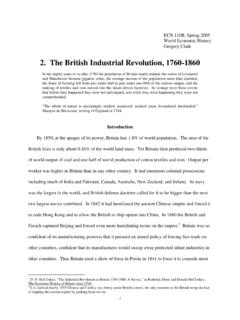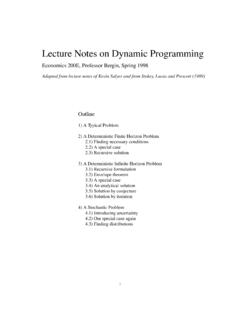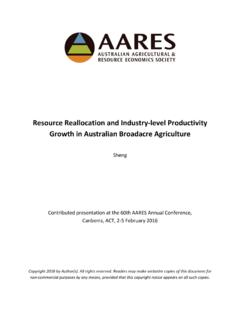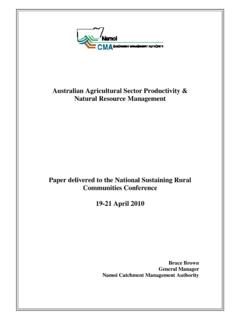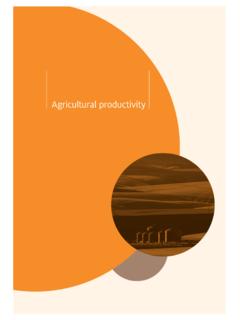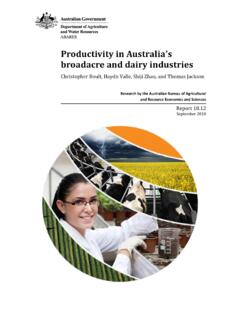Transcription of The Red Queen and the Hard Reds: Productivity Growth in ...
1 The Journal of Economic History, Vol. 62, No. 4 (Dec. 2002). The Economic HistoryAssociation. All rights reserved. ISSN L. Olmstead is Professor of Economics, Director of the Institute of Governmental Affairs atthe University of California, Davis, One Shields Ave., Davis, CA 95616-8617; and member of theGiannini Foundation of agricultural Economics. E-mail: Paul W. Rhode isProfessor of Economics at the University of North Carolina, Chapel Hill, Chapel Hill, NC 27599; andResearch Associate at the National Bureau of Economic Research. E-mail: have received valuable comments from Greg Clark, Jack Goldstone, D. Gale Johnson, BruceJohnston, Frank Lewis, Joel Mokyr, Jose Morilla, Philip Pardey, Vicente Pinilla, James Simpson,Vernon Ruttan, and from the seminar participants at UC Davis, Stanford University, NorthwesternUniversity, the University of Minnesota, the All-Chicago Economic History Group, Triangle EconomicHistory Workshop, the University of Alcala, the University of Zaragoza, the Victoria Department ofNatural Resources and Environment and the Victorian Branch of the australian agricultural andResource Economics Society, Melbourne, Australia, and the conference participants at the AustralianAgricultural and Resource Economics Society Conference, Christchurch, New Zealand, the EconomicHistory Association at Philadelphia, PA.
2 , and the Rutgers Center for Historical Analysis Conferenceon Industrializing Organisms. Lisa Cappellari, Susana Iranzo, and Shelagh Mackay provided assis-tance on this project. Lee Craig generously shared county-level data from the 1839 Census. Severalplant scientists, including Calvin Qualset, Charles Schaller, and Robert Webster provided valuableperspectives. As has become custom, we owe special thanks to Julian Alston and Peter Lindert for theirinsights, advice, and encouragement. This JOURNAL s editor and the anonymous referees also madesignificant contributions. Work on this article was facilitated by a fellowship granted by the Interna-tional Centre for Economic Research (ICER) in Turin, JOURNAL OF ECONOMIC HISTORYVOLUME 62 DECEMBER 2002 NUMBER 4 The Red Queen and the Hard Reds: Productivity Growth in American Wheat,1800 1940 ALAN L. OLMSTEAD AND PAUL W. RHODE Standard treatments of agriculture assert that, before the 1930s, productivitygrowth was almost exclusively the result of mechanization rather than biologicalinnovations.
3 This article shows that wheat production witnessed wholesalechanges in varieties and cultural practices during the nineteenth and early twentiethcenturies. Without these changes, vast expanses of the wheat belt could not havesustained commercial production and yields everywhere would have plummeted dueto the increasing severity of insects, diseases, and weeds. Revised estimates of Parkerand Klein s Productivity calculations indicate that biological innovations contributedroughly half of labor- Productivity Growth between 1839 and the mysteries of Productivity Growth has been one ofthe major contributions of the economics profession over the past half-century. Controversy still reigns for many contemporary issues such asexplaining the Productivity downturn in the 1970s and measuring the impact930 Olmstead and Rhode1 Cochrane, Development, p. 200, also see p. 107. Griliches s treatment is less emphatic, but appearsto lead to the same general conclusion.
4 Griliches, Agriculture, pp. 241 , Agriculture, pp. 7 and Ruttan, agricultural Development, p. and Klein, Productivity Growth , pp. 523 82. See also Walton and Rockoff, History,p. 334; Ratner et al., Evolution, pp. 264 65; Atack and Passell, New Economic View, pp. 280 82; andHughes, American Economic History, pp. 275 76. The theme is also standard fare in the USDA streatment of Productivity Growth . Loomis and Barton, Productivity , pp. 6 8. Historians have beenmore inclined to emphasize the importance of biological innovations. See, for example, Kloppenburg, First, pp. 50 65. Although Parker is best remembered for his estimates with Judith Klein that empha-size the importance of mechanization, elsewhere he expressed a strong appreciation for the importanceof biological innovations. Parker, Productivity , pp. 180 81, and Agriculture, pp. 369 Stanelle, Certified for a statement of this computers on recent economic performance.
5 But for the more distant pastthere is widespread consensus about the Productivity record of such coresectors as agriculture. According to the stylized facts, American agriculturebefore 1940 witnessed significant increases in labor Productivity resultingfrom mechanization but little Growth in land Productivity from biologicaladvances. As an example, Willard Cochrane argued that mechanization wasthe principal, almost the exclusive, form of farm technological advance between 1820 and In his Richard T. Ely Lecture, D. Gale Johnsonnoted that:While American agriculture achieved very large labor savings during the last century,which made it possible to continue expanding the cultivated area with a decliningshare of the labor force, output per unit of land increased hardly at all.. The revo-lution in land Productivity based on important scientific advances began very re-cently; its beginnings were in the 1930 s with the development of hybrid corn.
6 2 Yujiro Hayami and Vernon Ruttan repeatedly echo this theme in their com-parative analysis of international agricultural This view isalso a part of the mantra of most economic historians. It is the main lessonof William Parker and Judith Klein s classic study of labor-productivitygrowth in grain cultivation between 1839 and 1909, and it has become aprominent fixture in the economic-history existing literature would have us believe that before the developmentof a sophisticated understanding of genetics, biological knowledge in agri-culture essentially stood still, generating little or no boost to Productivity orproduction. This leads to the popular picture of nineteenth-century agricul-ture as a world of unchanging cropping patterns and cultural practices, aworld where each farmer sowed grain that he himself grew and that hisfather grew before him, a world of a happy, organic balance between culti-vators and their natural on wheat, this article argues that, contrary to the conventionalwisdom, the nineteenth and early twentieth centuries experienced a streamof biological innovations that rivaled the importance of mechanical changesRed Queen and Hard Reds9316In the context of the international-development literature the term biological change encompassesnonmechanical activities that modify the growing environment.
7 In addition to strictly biologicalinnovations such as improved plant varieties, biological changes include changes in cultural prac-tices, irrigation systems, fertilizers, and discussing wheat, modern agronomists have abandoned the term variety and adopted theterm cultivars in its place because of the subtle distinctions as to what properly constitutes a distinctvariety. Because the historical literature we cite consistently refers to varieties, we have chosen touse the dated USDA economists have promoted the general view that mechanical technologies domi-nated biological innovations in the pre-1940 era. For example see Loomis and Barton, Productivity , pp. 6 8. In an excellent article on biological innovation in wheat, another USDA economist, DanaDalrymple, hits on this issue noting the effect of some yield-increasing technologies may have beenmasked by disease or other problems, but he fails to develop the implications of this insight.
8 Insteadhe repeats the standard mantra that mechanical technologies were of major importance well beforebiological technologies. The key point is that just because yields were relatively constant does notnecessarily imply that biological innovation was of minor importance. Dalrymple, Changes, p. 20 agricultural - Productivity These new biological technologiesaddressed two distinct classes of problems. First, there was a relentlesscampaign to discover and develop new wheat varieties and cultural methodsthat would allow the wheat frontier to expand into the northern prairies, theGreat Plains, and the Pacific Coast Without these land-augmentingtechnologies, western yields would have been significantly lower, and vastareas of the Great Plains would not have been able to sustain commercialwheat production. Second, researchers and wheat farmers made great stridesin combating the growing threat of yield-sapping insects and diseases, manyof which were the unintended consequences of biological the large-scale importation of Eurasian crops to North America camehitchhikers who fed on and destroyed those crops.
9 In the absence of vigor-ous efforts to maintain wheat yields in the face of evolving foreign anddomestic threats, land and labor Productivity would have been Although practices were not as effective as post World War II tech-nologies, early farmers applied a variety of integrated pest managementsystems with considerable success. Building on our analysis of pre-1940biological innovations, we take a fresh look at Parker and Klein s formalestimates of labor- Productivity Growth between 1839 and 1909. Our revisedestimates suggest that biological innovations accounted for roughly one-halfof the labor- Productivity Growth in this period. CORNERSTONES OF THE CONVENTIONAL WISDOMThe lesson that biological innovations were unimportant in wheat cultiva-tion before 1940 rests on two fundamental building blocks. The first is thetime series on yields, which is graphed for the 1866 1969 period inFigure 1. The figure also includes the Growth trend with a break in 1939,which maximizes the fit.
10 Output per acre harvested was nearly constant from1866 to 1939, growing only about percent per annum. This amounted932 Olmstead and Rhode9 The use of average national yields to measure land Productivity is subject to obvious conceptualdifficulties. The following reasoning, for which we thank Frank Lewis, helps illustrate some of thesample selection problems involved. Suppose potential wheat land may be ranked along a scale accord-ing to its yield capacity. Given prevailing farm prices and costs, there will be a minimum yield forwhich it is profitable to devote the land to wheat cultivation. Land ranked below this threshold will gouncultivated and the average measured yield is based only on land above the profitable-cultivationthreshold. Now consider the effect of a yield-increasing biological innovation, which like many of thoseconsidered in this article, disproportionately increases yields on low-yielding lands. This will raisemore land above the threshold, pushing out the frontier of wheat cultivation, and increase total produc-tion.




